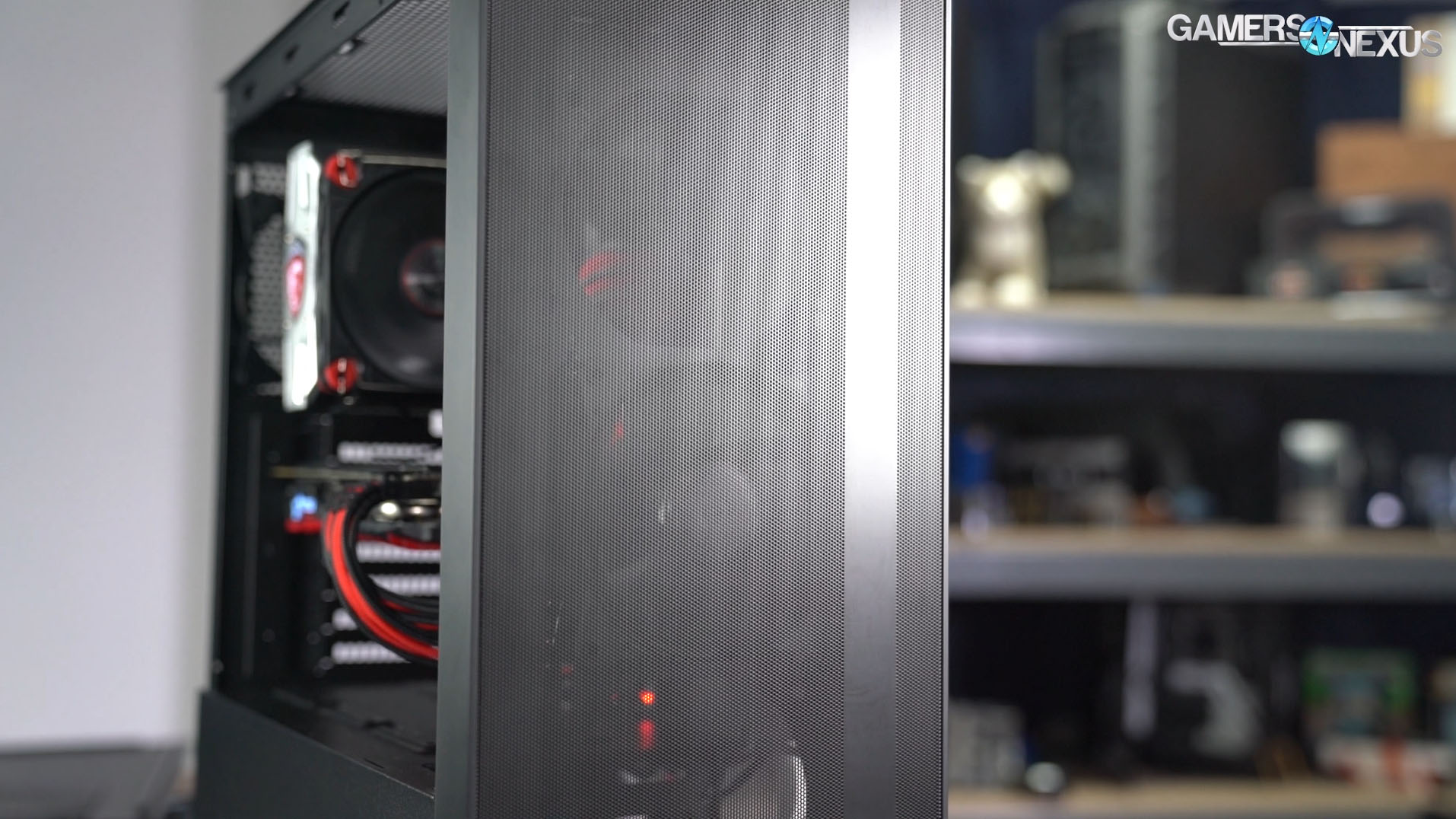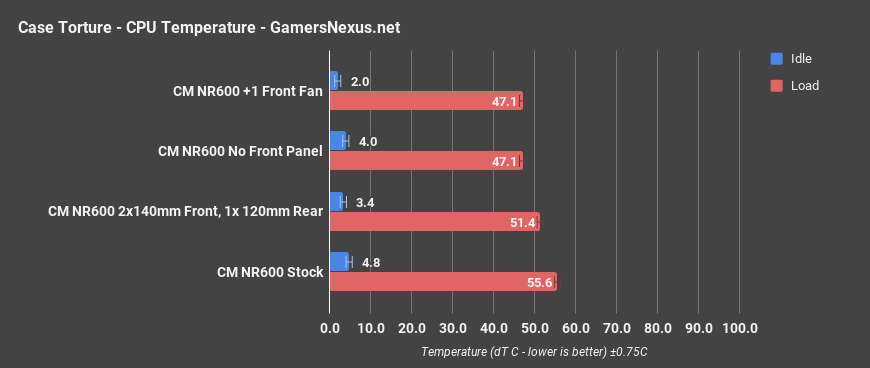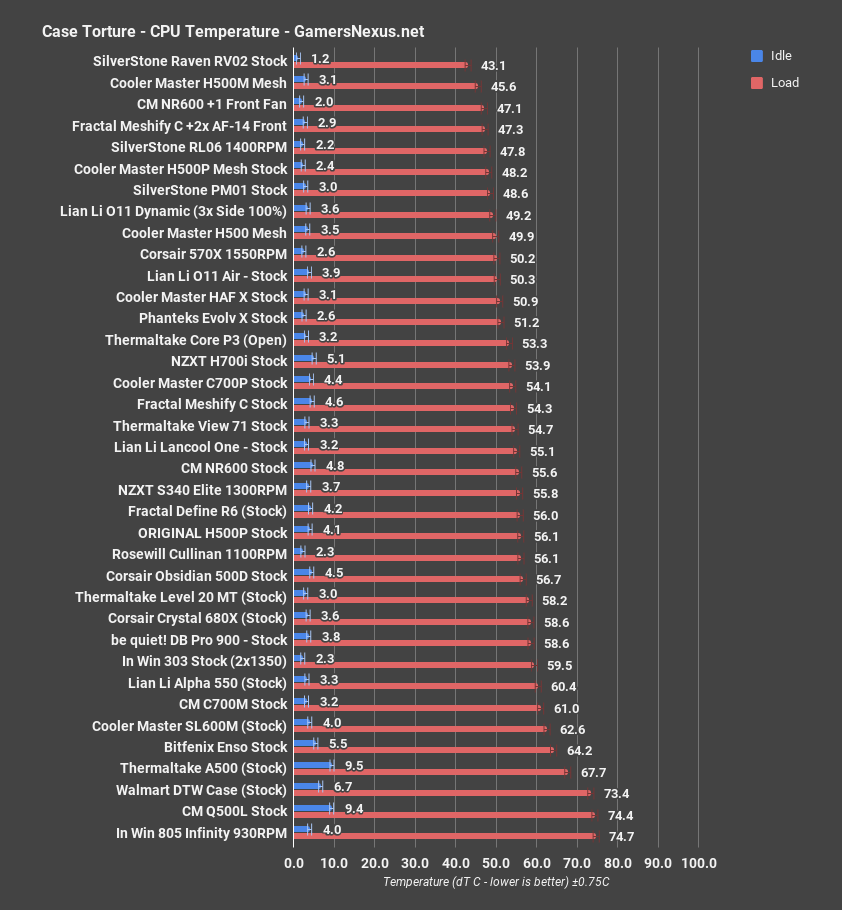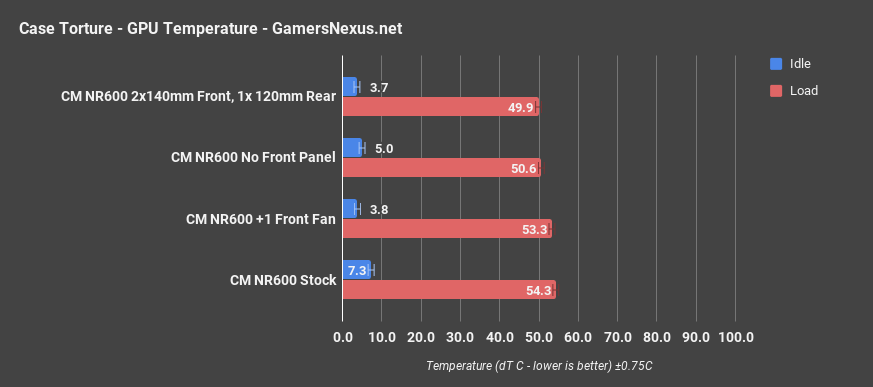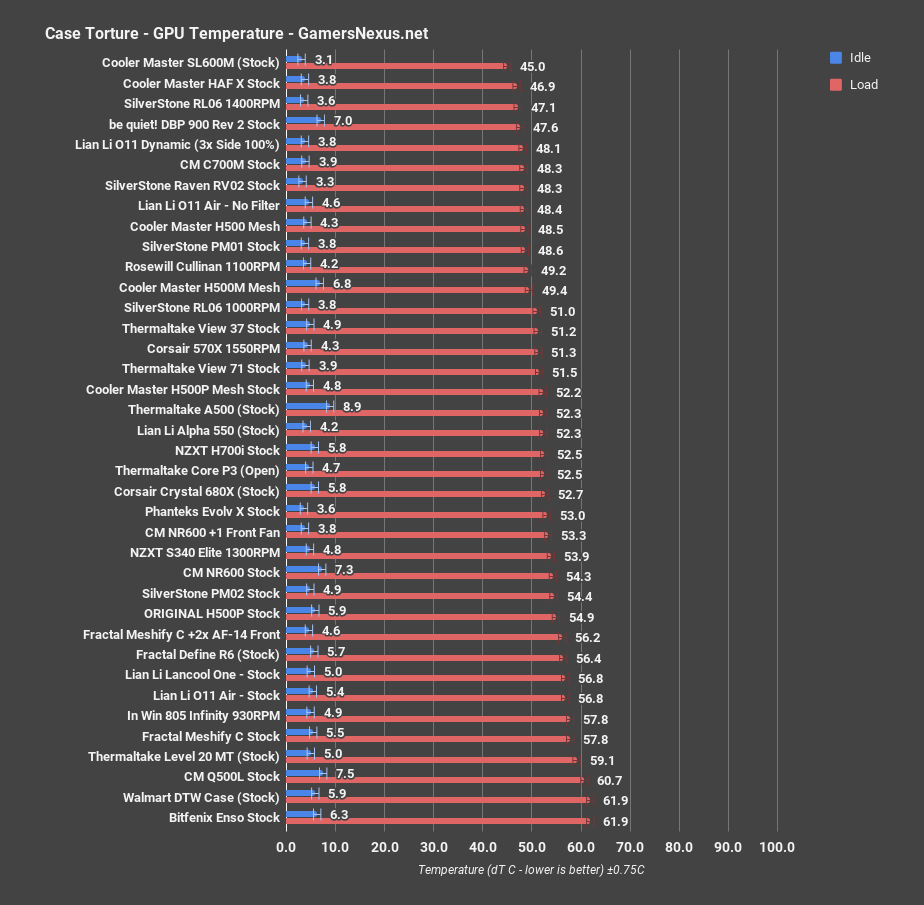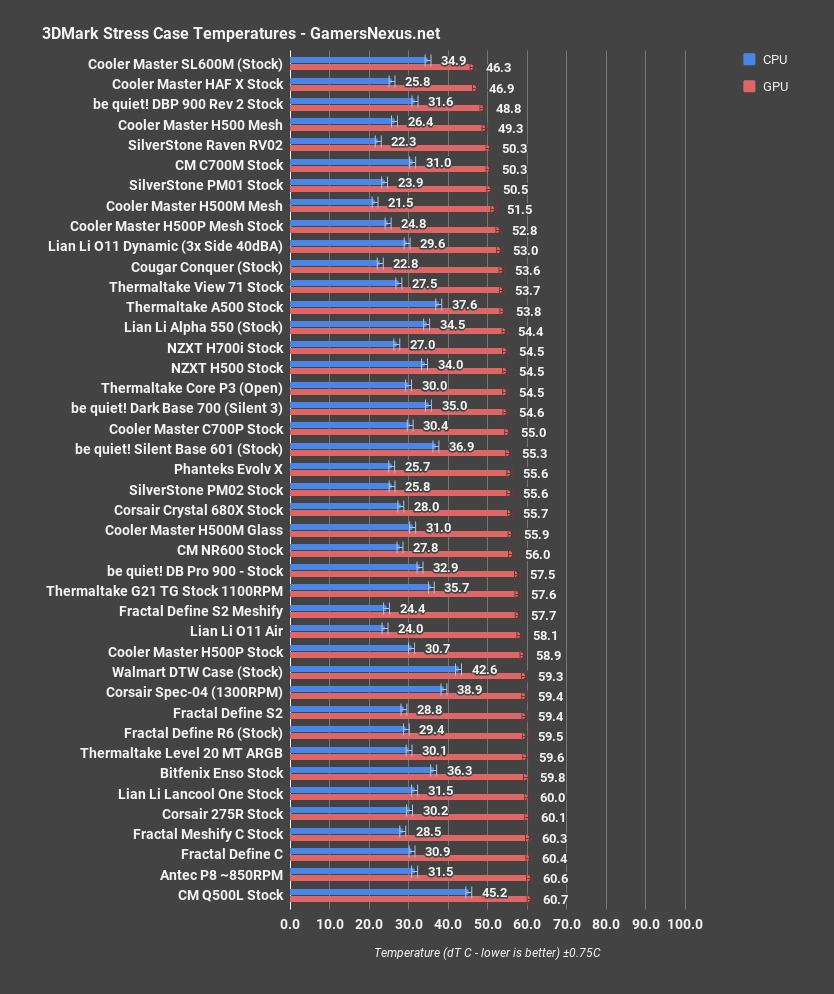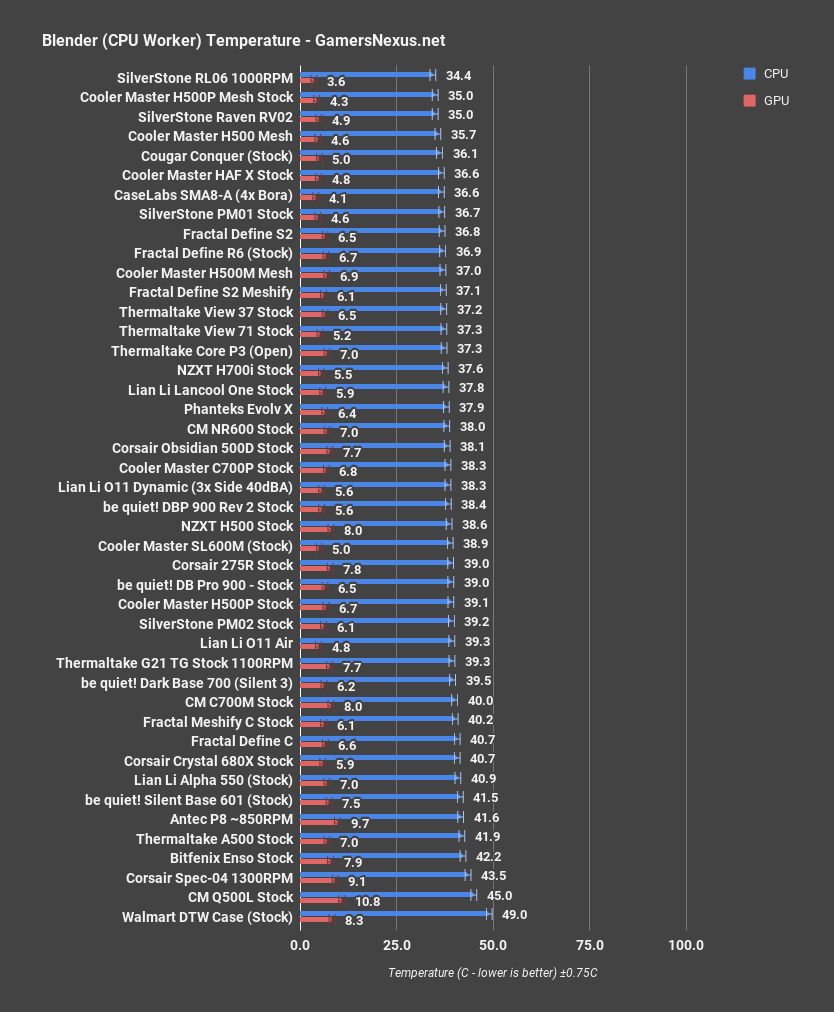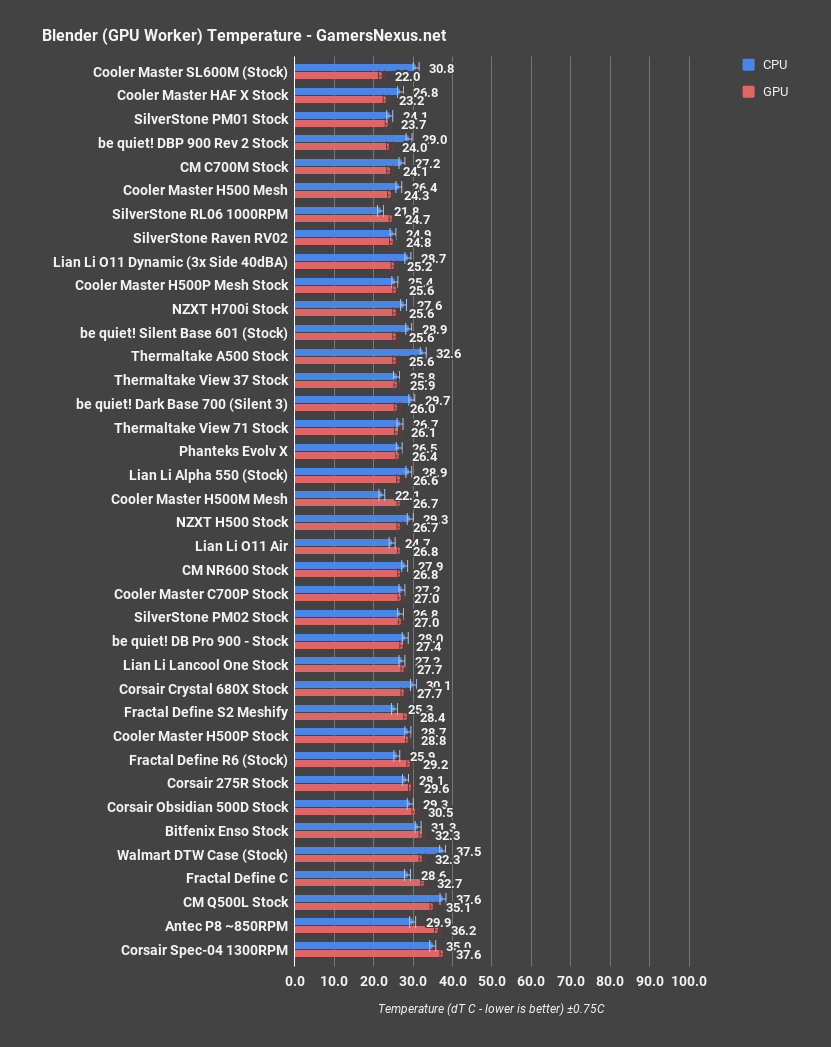Cooler Master sent over its NR600 enclosure at the same time as the Q500L, but we judged it a little less time sensitive since there wasn’t any melting candy inside of it. The NR600 is a budget mesh-fronted mid tower moving in on the market segment that the RL06 used to occupy, back when it was around $70.
At first glance, the Cooler Master MasterBox NR600 bears a strong resemblance to the NZXT H500, mostly thanks to the partial glass panel that cuts off at the level of the PSU shroud, but also the flat, unadorned exterior. Cooler Master has gone increasingly minimalist with their branding, which is limited to a logo-shaped power button and an embossed hexagon on the side of the PSU shroud. We went so far as to put the NR600 side-by-side with the H500 for comparison, but their glass panels are in fact slightly different sizes.
Cooler Master NR600 Specs
Product Name | MasterBox NR600 |
Exterior Color | Black |
Materials - Body | Steel, Plastic |
Materials - Windowed Side Panel | Tempered Glass |
Dimensions | 478 (L) x 209 (W) x 473 (H) mm |
Motherboard Support | Mini-ITX, Micro-ATX, ATX |
Expansion Slots | 7 |
5.25" Drive Bays | N/A (MasterBox NR600 without ODD) 1 (MasterBox NR600 with ODD) |
3.5" HDD Drive Bays | 4 |
2.5" SSD Drive Bays | 5 |
I/O Panel - USB Ports | USB 3.0 x 2 |
I/O Panel - Audio In / Out | 1x 3.5mm Headset Jack (Audio+Mic) |
Pre-installed Fan(s) - Front | 120mm x 1 |
Pre-installed Fan(s) - Rear | 120mm x 1 |
Fan Support - Front | 140mm x 2 / 120mm x 3 (MasterBox NR600 without ODD) 140mm x 2/ 120mm x 2 (MasterBox NR600 with ODD) |
Fan Support - Top | 140mm x 2 / 120mm x 2 |
Fan Support - Rear | 120mm x 1 |
Radiator Support - Front | 360 / 280 / 240 / 140 / 120mm (MasterBox NR600 without ODD) 280 / 240 / 140 / 120mm (MasterBox NR600 with ODD) |
Radiator Support - Top | 240mm / 120mm (MasterBox NR600 without ODD) (35mm max motherboard component height) 240mm (with ODD removed) / 120mm (MasterBox NR600 with ODD) (35mm max motherboard component height) |
Radiator Support - Rear | 120mm x 1 |
Clearance - CPU Cooler | 166mm / 6.54" |
Clearance - Power Supply | 180mm / 7.08" |
Clearance - Graphics Card | 410mm / 16.14" |
Cable Routing - Behind MB Tray | 20~28mm / 0.78~1.10" |
Dust Filters | Top, Bottom |
Power Supply Support | Bottom Mount, ATX |
MSRP | $70 |
Cooler Master NR600 Build
A glance might not make it clear how much more ventilated the NR600 is than the H500, though. The NR600’s front is covered with a fine mesh that acts as both a filter and a front panel, hopefully avoiding the thermal problems that some cases introduce by backing mesh with additional layers of filtration. Dust will gather on the outside and some will inevitably get through, but it’s easy to wipe down and the front panel comes off easily. We prefer this solution. By opting out of a filter they’ve also made it possible to mount fans on the outside of the chassis, nearly flush with the front panel, which should draw more air from outside of the case instead of just recirculating it inside.
The mounts inside the front panel have three perfectly-sized ducts for 120mm fans, but not so for 140mm ones. Two 140mm fans are supported, but they don’t line up with the cutouts and the mounting holes are at the bottom of the panel rather than the top, so there’s no way to point a 140mm intake fan directly back towards the CPU cooler. There are also just a couple of mounting holes that are too small for fan screws (although they would fit radiator screws). Cooler Master includes two 120mm fans with the case, one intake and one exhaust, which is (much like the Meshify C) enough for the case to function but not really excel. It’s difficult to install fans of any size in the bottom-most slot because of the HDD cage, which is riveted in place and prevents most screwdrivers from fitting under the PSU shroud. A removable fan/radiator bracket would solve this completely, but also add to production costs.
Opening up the case for the first time revealed two minor fit-and-finish issues: first, there was the tip of a broken-off rivet (nothing structural) loose in the bottom of the case, and second, the glass panel doesn’t slide all the way forward to fit flush against the front panel. The glass is supposed to be slotted in, slid forward,and screwed into place, but since it can’t slide forward that last millimeter or so, the metal tabs at the rear of our case were bent slightly when the thumbscrews were tightened down at the factory. This also doesn’t affect function, but it is visible from the outside of the system.
The other side of the case uses an old-school steel panel with tabs that hook into the case, but it’s thick enough and the cable management space is wide enough that there isn’t much danger of the panel bowing out when it’s being put back on, which is usually the biggest annoyance with that style of panel. The cable cutouts on the motherboard edge, the clearance for cables, and the tie points that are well-placed for velcro straps make cable management pretty good. The riveted HDD cage is the only roadblock, since it makes it more difficult for users to repurpose that space for storing power cables.
The top of the case has a vent roughly 30cm long, or large enough to fit two 140mm fans. Its magnetic filter is shipped stowed inside the side panel, which is a great strategy to keep us from using it our stock test and hurting thermals. The filter for the PSU vent on the bottom of the case is just a square of mesh that fits into cutouts on the case. It pops out easily and it’s annoying to put back in, but it’s also fairly standard for this price range.
Front I/O is limited to two USB ports and one four-pole (combined in/out) audio jack. Cooler Master advertises the combined jack as a feature, but plenty of headsets split mic/headphone cables out to two separate 3.5mm jacks, so it’s just as likely to be a limitation. Whether it’s a benefit or a drawback comes down to what the user already owns, though. On the other hand, Cooler Master may have made up for this in the compatibility department by selling a version of the case with a 5.25” bay. We rarely bother to comment on support for optical drives at this point, but it’s something that other mesh-fronted cases like the Meshify C, RL06, or the various Cooler Master H500 variants shy away from. The ODD model of the case is a separate SKU and doesn’t seem to be on sale yet at the time of this writing.
GN Case Testing Bench (Sponsored by CableMod)
| Component | Courtesy Of | |
| Video Card | MSI GTX 1080 Gaming X (OC Mode) | MSI |
| CPU | Intel i7-6700K @ 4.4GHz | GamersNexus |
| CPU Cooler | MSI Core Frozr L | MSI |
| Motherboard | MSI Z170A Gaming M7 | MSI |
| Memory | Corsair Vengeance LED 32GB 3200MHz | Corsair |
| SSD | Samsung 850 EVO 120GB | Samsung |
| PSU | Corsair RM650x | Corsair |
| Cables | CableMod Pro Mesh Cables | CableMod |
| Case | This is what we're testing! | - |
The video card is configured to run at 55% fan speed at all times.
Prior to load testing, we collect idle temperature results for ten minutes to determine the unloaded cooling performance of a case's fans and air channels. Thermal benchmarking is conducted for 1400 seconds (23 minutes), a period we've determined sufficient for achieving equilibrium. The over-time data is aggregated and will occasionally be compiled into charts, if interesting or relevant. The equilibrium performance is averaged to create the below charts.
Load testing is conducted using Prime95 LFFTs and Kombustor “FurMark” stress testing simultaneously. Testing is completely automated using in-house scripting, and executes with perfect accuracy on every run.
We recently validated our test methodology using a thermal chamber, finding our approach to be nearly perfectly accurate. Learn more here.
CM NR600 Thermals & Noise
For standardized fan testing, we’ve picked two 140mm 1500RPM Noctua fans to use as intake (one designated upper, one lower) and one 120mm 1500RPM Noctua fan as exhaust. Almost every ATX case we’ve reviewed over the past couple years supports two 140mm intake and one 120mm exhaust fan. Other than that, we tested without the front panel as usual, and did one final test with an extra 120mm 1500RPM intake fan to see what performance would be like if a user chose to just buy one additional fan.
NR600 Torture Test - CPU
We’ll start the CPU torture thermals with just the NR600, then we’ll add it to the comparative chart versus other cases. With the Cooler Master NR600 under full stock conditions, we measured CPU thermals at 55.6 degrees delta T over ambient when running the torture workload, with idle at about 4.8 degrees Celsius. Simply adding a Noctua 1500RPM 120mm fan to the front dropped CPU thermals to 47 degrees over ambient, a reduction of about 8.5 degrees. If you’re buying this case, one of the best things you can do is purchase one 120mm fan. The improvement is because we’ve now created a straight front-to-back airflow path for the CPU tower cooler, benefiting our configuration greatly. That doesn’t mean the case is bad in its stock configuration – it’s actually not bad overall – but does suggest that there’s a lot to be gained from adding one fan. This is great news, actually, because it means that Cooler Master’s front mesh design is sufficiently constructed such that fan configuration changes have meaningful, significant impact to thermals. Removing the front panel entirely has functionally the same effect on thermals as adding a fan, which is because we’ve now opened up air to the CPU tower fan to directly intake without obstructions and pressure inhibitors. Adding a fan and removing the panel are nearly synonymous, which indicates minimal obstruction to airflow with the panel design. Replacing the fans with 2x 140mm fans in the front yielded worse performance for the CPU than just adding one 120mm, and that’s because of the awkward, poor fitment of 140mm fans in this case. We wouldn’t recommend them.
Here’s the comparative chart. 55.5 degrees Celsius CPU dT is average on this chart, just a little warmer than the Meshify C stock. It’s in the same boat as Fractal’s Meshify: great cooling potential, but short on fans when stock. Adding a single fan to achieve the 47.1 degree result makes the NR600 much more competitive, and puts it on the level of the long-praised SilverStone RL06, another mesh-fronted case that ships with a full complement of four 120mm fans. There’s always a pick-two balance to be struck between case price, number of fans, and quality of fans, but both Cooler Master and Fractal prioritized price. The user is left, and encouraged, to purchase at least one extra fan or shove a CLC in the case somewhere.
NR600 Torture Test - GPU
GPU torture thermals are next, starting again with a limited chart. The baseline torture GPU temperature with the stock case configuration was 54.3 degrees Celsius, which dropped to 50.6 degrees with the front panel removed. This lack of reduction versus the CPU results is because the single intake fan is aimed more towards the bottom of the case, benefiting the GPU in the stock configuration. This is probably best, as the GPU is more thermally sensitive and will boost pursuant to core temperatures. Adding a single front intake fan did little for the GPU, unsurprisingly, as we pointed it straight at the CPU cooler. We measured a 1-degree reduction, which is within our error margins. We do not have the test resolution to state if this is a meaningful change or just statistical variance. Swapping to the lopsided dual-140 configuration further reduced thermals, bringing us down to 49.9 degrees. In this setup, because the top doesn’t accommodate a 140 properly in favor of an optical drive support, the GPU receives most of the air.
Here’s the comparative chart. A baseline of 54.3 degrees is on the warm side, judged against our other cases, but still well under control. To be fair, the stock Meshify C averaged 57.8 degrees dT over ambient in this test. With a full set of four 120mm fans (three intake, one exhaust) in this case, we’d probably see scores comparable to the RL06 across the board. One of the advantages of mesh-fronted cases like this is that adding more fans will continue to improve performance.
3DMark Thermals
Running the Firestrike Extreme stress test on a loop averaged 56 degrees over ambient for GPU thermals, a couple degrees higher than the torture test. That places it in the middle of the chart again, but two degrees below the stock Meshify S2 and four below the stock Meshify C – we’re emphasizing “stock” because these cases would perform better with additional fans if they were purchased, but that’s also true for the NR600, which we ran stock in this test. Stock intake fans that have to supply air to both the CPU and GPU are never a great compromise, but with airflow biased towards the GPU, the NR600 manages to pull through reasonably well in this test.
Cooler Master NR600 Blender Benchmarks
The blender CPU render averaged 38C CPU dT, a full two degrees below the Meshify C. It’s within margin of error of the NZXT H500, which is practically the same thing but with a sealed-off front panel. Mesh is great, but without an extra fan or two to take advantage of it, no more air will come in than it would in a more restricted case.
With the blender GPU render, GPU dT averaged 26.8C. That’s again significantly better than the Meshify C, but just about tied with the NZXT H500, as well as the Lian Li O11 air. Those are both fine cases, but again the NR600 could do better with some additional fans, as seen in the torture tests. The stock fan does a decent job of moving cool air in along the surface of the PSU shroud, but it doesn’t force a wall of air through like the RL06.
CM NR600 Noise Tests
Noise testing is up next. 38.7 dBA is almost precisely the same as we measured the stock Meshify C, which makes sense. The open mesh front doesn’t do much to muffle noise, but the two stock fans also don’t generate much. This case is reasonable overall, just know that adding more fans will affect the noise given the front panel design. That said, we’ve previously demonstrated that mesh cases can be better tuned acoustically by simply dropping fan RPM, which is a benefit not afforded by most silence-focused cases as they need higher pressure to pass all the obstructions.
Conclusion: Cooler Master NR600 vs. Meshify C & NZXT H500
The NR600 is a solid budget case, but it is a budget case. Buyers should be aware that the two 1200RPM fans aren’t the greatest, there are no drive sleds anywhere, the HDD cage is riveted in place, the filters are just squares of mesh, and whatever other caveats typically come with a $70 case. If all that’s acceptable, it’s a simple enclosure that’s easy to build in and has exceptional airflow with some extra fans. Even stock, the thermal performance is acceptable. The strongest competition in this price range is the NZXT H500, which has a different look but worse airflow, and the Meshify C, which costs a little more and also needs fans added. The RL06 may also still be a competitor, but as it ages prices are creeping up.
Cooler Master’s NR600 is the exact opposite of its Q500L. The NR600 has highly competitive airflow, even with the stock two fans, and still manages to convert the mesh front into a self-serving dust filter. Job well done overall on this one.
Host, Test Lead: Steve Burke
Testing, Editorial: Patrick Lathan
Video: Andrew Coleman
